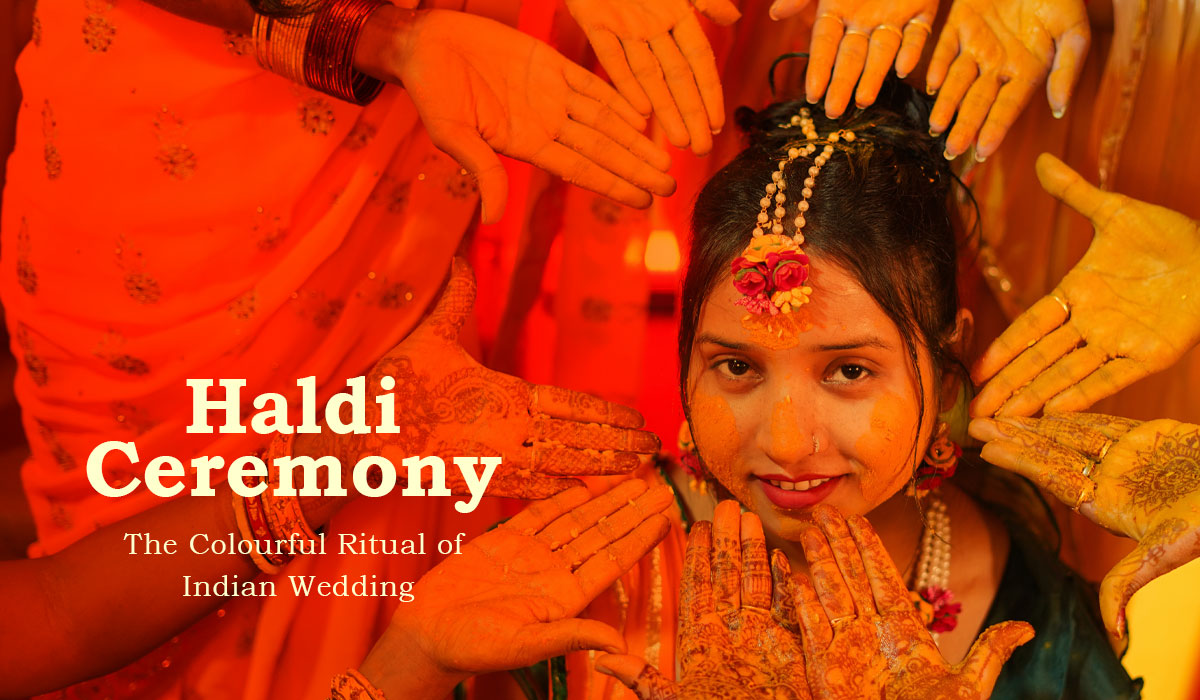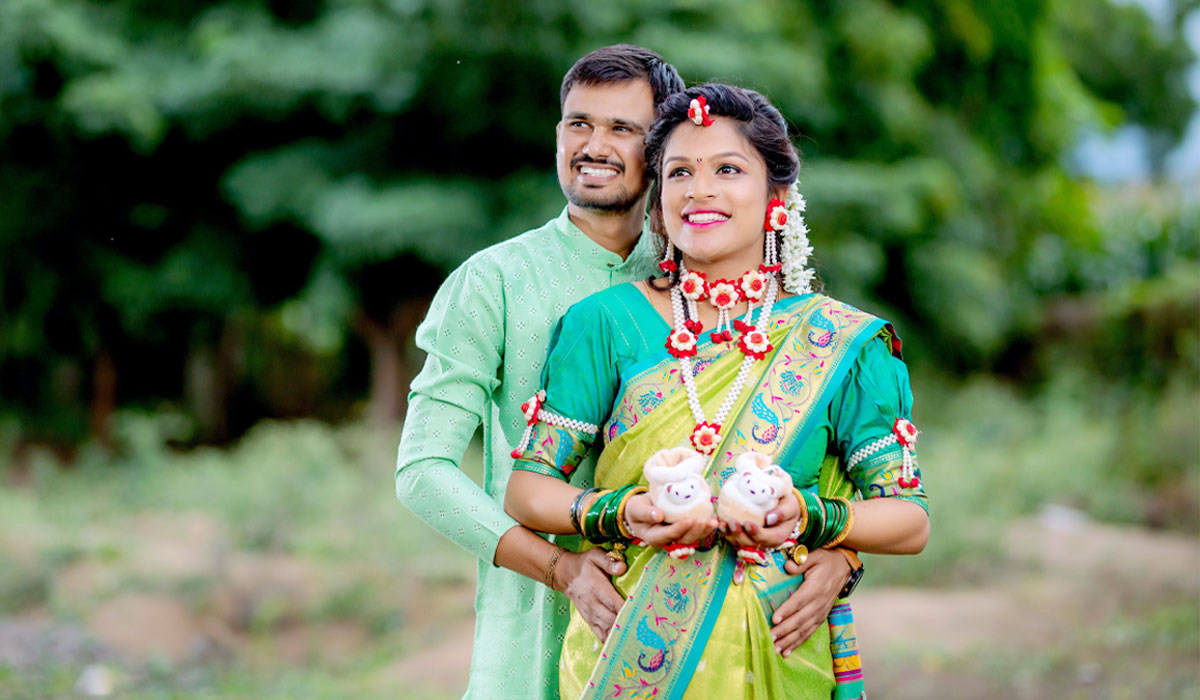A Festival not only means joy and happiness, but it also means an essential display of tradition, values, and culture. Almost every day India celebrates a unique festival. Some are religious, national, and cultural or harvest festivals. Every state in India has its major festival and people become culturally alive during this time. In this article, we are going to explore the top 20 cultural festivals in India based on their geographical location or states.
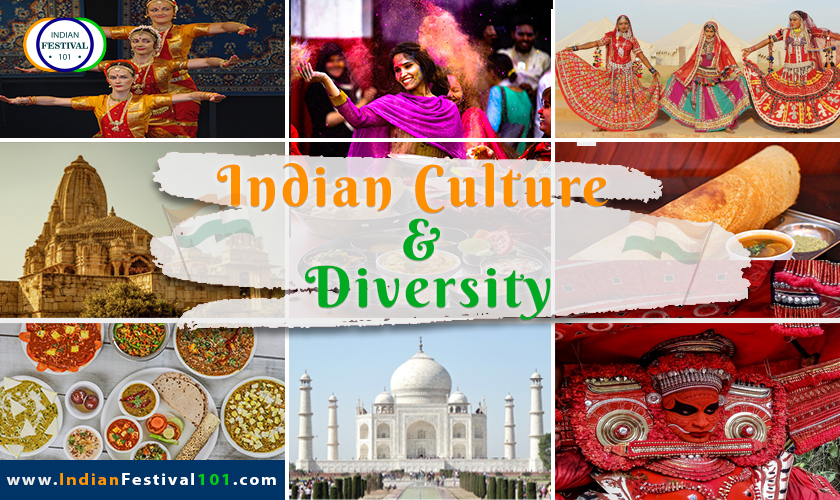
Dussehra, All Over India
Dussehra is also a popular cultural festival in India. This festival unfolds a spectacle of grand processions, effigy burnings, and traditional performances. This vibrant festival marks the triumph of good over evil, commemorating Lord Rama’s victory over the demon king Ravana. The air resonates with the beats of drums and the aroma of festive delicacies.
Eid-ul-Fitr, All over India
Step into the enchanting world of Eid-ul-Fitr, a celebration that radiates joy and camaraderie across India. This cultural extravaganza marks the end of Ramadan, the holy month of fasting. Families gather for communal prayers, sharing festive meals and delectable treats. Streets come alive with the spirit of giving as people exchange gifts and extend charity to the less fortunate. The vibrant tapestry of colourful attire and the aromatic allure of traditional dishes paint a picture of unity and gratitude.
Diwali, All Over India
India’s cultural splendour with Diwali, the Festival of Lights. This exuberant celebration signifies the victory of light over darkness and good over evil. Homes dazzle with vibrant lamps, intricate rangoli designs adorn doorsteps, and the night sky ignites with fireworks. Families unite, exchanging sweets and gifts, while the air is steeped in the sweet fragrance of festive delicacies. Diwali transcends religious boundaries, embodying a universal spirit of hope and renewal.
Holi, All Over India
Holi, India’s exuberant Festival of Colors. This joyous celebration marks the arrival of spring, where people revel in vibrant hues, drenching each other in coloured powders. Streets resonate with laughter and music as communities come together, breaking barriers of caste and creed. Traditional sweets, like gujiyas, add sweetness to the festivities, and the air is filled with the rhythm of celebratory folk songs. Holi’s contagious spirit fosters unity, symbolizing the triumph of good over evil and the blossoming of friendships amidst the riot of colours.
Jaisalmer Desert Festival, Rajasthan
the Jaisalmer Desert Festival. Set against the breathtaking backdrop of the Thar Desert, this vibrant celebration showcases the rich tapestry of Rajasthani traditions. Revel in folk music echoing through the golden dunes, witness mesmerizing folk dances, and marvel at the elaborate displays of local artistry. Turban tying competitions, camel races, and the enchanting Mr. Desert contest add to the festival’s unique charm. The desert comes alive with a kaleidoscope of colours, mirroring the vivacity of Rajasthan’s cultural heritage.
Garba Dance Festival- Gujarat
Pushkar Mela- Rajasthan
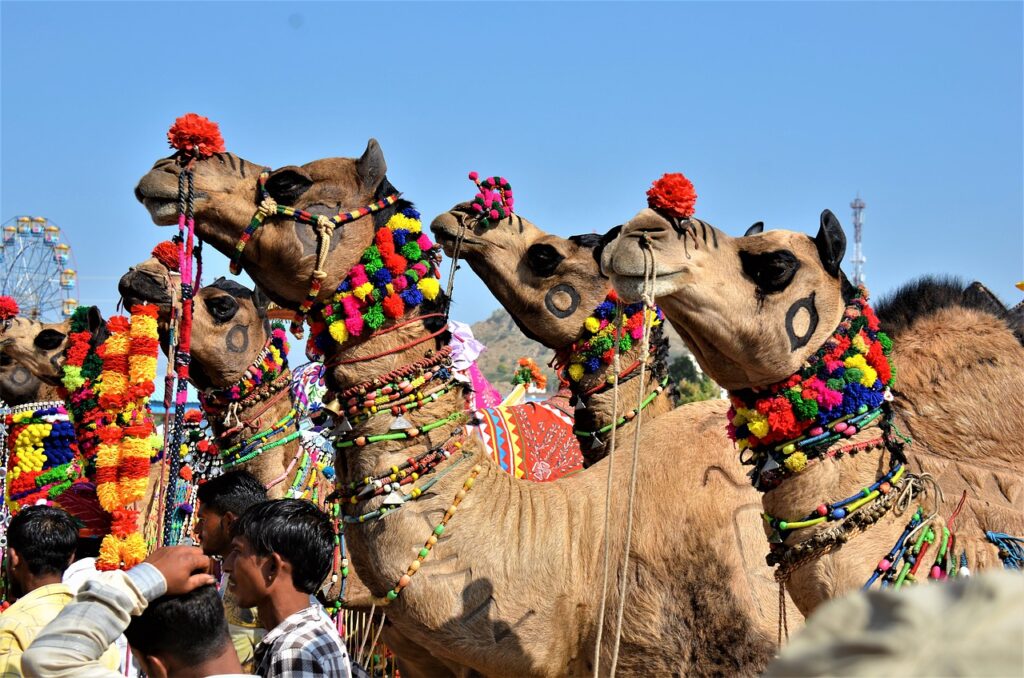
Puskar Fair or Mela is the largest fair in the state of Rajasthan, The Pushkar Fair as the name suggests is a camel and livestock fair held all across the town of Pushkar. In this fair, camel and cattle traders get together to do business at the holy Kartik Purnima festival. The men are busy with the goats, camels, sheep, and cows while the women pass their time in the stalls selling native jewellery, clothes, and textiles. Apart from the regular transactions of livestock, several competitions are held such as ‘The longest moustache’, ‘The bridal competition’, ‘Breaking the pot (Matka Phod)’, and many more.
The fair is held during October and November. The fair attracts tourists from all over the country and the world.
Also Read:- List of Fairs in India
Mewar Festival- Rajasthan
Mewar Festival is the cultural festival of Rajasthan celebrated in Udaipur. The festival is celebrated to mark the arrival of the spring season. This festival has a vast history and has been celebrated since the Sisodia Dynasty was ruling India. If you want to be a witness to the cultural and traditional aspects of Rajasthan at large, you shouldn’t forget to attend this festival. Know more About Rajasthan Culture and Tradition. Visit here:- Rajasthan Culture and Tradition
Onam Sadhya- Kerala
Onam is a South Indian Festival celebrated in Kerala State. It is the major festival of Kerala that marks the Malayalam New Year. Onam is celebrated for ten days in August or September, it celebrates the homecoming of the legendary king Mahabali.
Onam festival is deeply attached to Kerala Culture, thus this festival is considered the Cultural Festival of Kerala. People decorate their homes with beautiful flower arrangements and dress in their finest traditional clothes. They wear traditional wear, adorn houses with Pookalam (floral designs), and prepare Onasadya (an elaborate meal of about 13 dishes).
Many cultural events are organized during the Onam Festival. legendary boat races are held and a variety of dances are performed such as the tiger dance, women’s dance, and mask dance. Folk songs are sung and martial arts are displayed. The streets are full of festive colours and flowers. Know more- Onam Festival of Kerela
Thrissur Pooram- Kerala
Thrissur Pooram is a South Indian temple festival held annually in Kerala. The festival is celebrated to commemorate the establishment of 10 temples around Vadakkunnathan Temple. It was mainly started by Raja Rama Verma and the surrounding temples participated in the festival.
The festival has events like Flag Hoisting (Kodiyettam), Firecrackers, displays of ornamental caparisons, royal fans, peacock feathers, and sacred bells. If you want to see the beauty of the South Indian Festival Especially Kerala Festivals, You should attend Thrissur Pooram.
Pongal- Tamil Nadu
Pongal is a harvest festival that transcends seasons. Celebrated with warmth and devotion, Pongal honours the sun god and the bountiful harvest. Homes come alive with the aroma of freshly harvested rice cooking in clay pots, signifying prosperity. The jubilant festival includes traditional music, dance, and colourful Kolam decorations adorning doorsteps. Witness the skies adorned with kites, symbolizing the spirit of joy and unity. know more: Pongal Festival
Thaipusam Festival- Tamil Nadu
Thaipusam is a captivating cultural festival celebrated predominantly by the Tamil community. Honouring Lord Murugan, devotees embark on a symbolic pilgrimage, often carrying Kavadis adorned with peacock feathers and milk pots. The piercing of skin and elaborate body piercings, known as vel kavadi, demonstrate immense devotion and self-sacrifice. Chants, rhythmic music, and the heady scent of incense fill the air as the procession winds its way to temples. Thaipusam unfolds as a poignant expression of faith and endurance, offering a profound glimpse into the spiritual fervour that defines this unique South Indian festival.
Bihu Festival- Assam
Bihu is a northeast Indian Festival celebrated in the Assam State. A celebration of spring- in nature as well as of life, the Bihu dance is a joyous experience that sees men and women alike perform folk Bihu songs. Traditional Assamese wear and jewellery enhance further the spritely zest of the dance performances characterized by rapid hand movements and a rhythmic swaying of hips that is itself quite a delight to watch.
Hornbill Festival- Nagaland
The Hornbill Festival is a North-East Indian Festival celebrated in Nagaland State. Hornbill festival is generally called the Festival of Festivals. It is a week-long Festival celebrated from the 1st to the 7th of December in Kohima, the capital of Nagaland.
Hornbill is all about celebrating ancient tribal traditions, lifestyles, and heritage. Each tribe of the state take part in this beautiful festival of colours and traditions. Several stalls are set up at the festival to display art and crafts, and herbal medicine. Various activities take place throughout the week such as games, beauty contests, rock bands, traditional archery, Naga dance, wrestling horse-riding, painting, flower show, chilli eating challenge, and much more. If you want to see a glimpse of the cultural and traditional heritage of the North East, especially the Nagaland people, you should plan your trip to Nagaland during the Hornbill festival.
Durga Puja- West Bengal
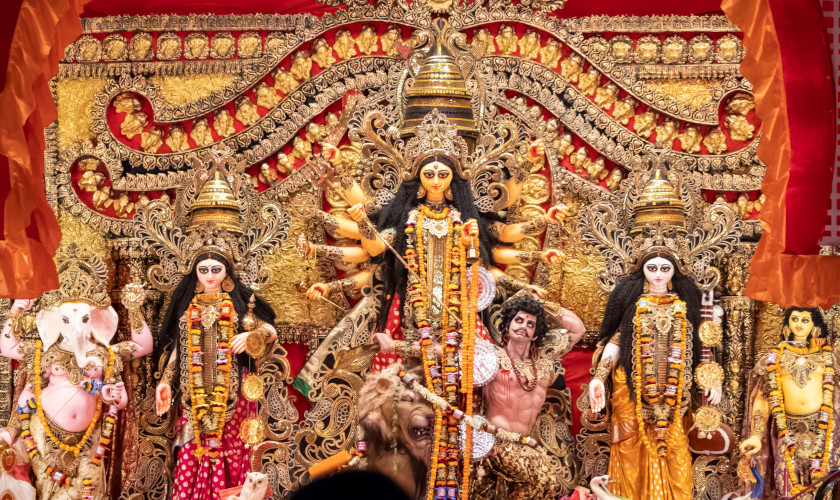
Undoubtedly, the Durga Puja is a Cultural Festival in Bengal. Durga Puja festival celebration continues over several days and is named Maha Panchami, Maha Shashti, Maha Saptami, Maha Ashtami, Maha Navami, and Bijaya Dashami. The festival marks the triumph of good over evil. The festival falls mostly in the English month of October.
Mahalaya Amavasya marks the inception of the festival and on that auspicious day, people give tributes to their deceased relatives. The festival ends with ‘Kojagori Lakshmi Puja’, which is the worship of Goddess Lakshmi on a full moon night.
Also Read – Durga Puja in Bengal
Khajuraho Dance Festival, Madhya Pradesh
Embark on a captivating journey into the heart of India’s cultural heritage with the Khajuraho Dance Festival. Against the backdrop of the ancient Khajuraho temples, this mesmerizing event showcases classical dance forms, breathing life into the intricate carvings that adorn the temples’ walls. Renowned dancers from across the country grace the stage, presenting a kaleidoscope of Bharatanatyam, Kathak, Odissi, and more. The festival, set amidst the UNESCO World Heritage Site, transcends time, offering a magical convergence of history, architecture, and the grace of classical dance.
Kite Festival, Gujarat
India’s Kite Festival is a jubilant celebration that paints the heavens with a riot of colours. This lively event, often associated with the harvest season, sees the skies adorned with countless kites of all shapes and sizes. Families gather on rooftops, engaged in friendly duels to cut each other’s strings, creating a spectacle of skill and camaraderie. The air is filled with the rhythmic sounds of kite battles and the joyous shouts of participants.
Ganesh Chaturthi- Maharashtra
Ganesh Chaturthi is a cultural extravaganza that reveres Lord Ganesha, the harbinger of good fortune and wisdom. Celebrated with fervour across India, the festival kicks off with the installation of elaborate Ganesha idols in homes and public spaces. The air is filled with devotional chants, rhythmic beats, and the aroma of festive delicacies. Processions lead to colourful immersion ceremonies, where communities bid a fond farewell to the beloved deity. Ganesh Chaturthi is a tapestry of tradition, joy, and unity, echoing the belief that Lord Ganesha’s blessings bring prosperity and remove obstacles. Know more: Ganesh Chaturthi
Goa Carnival, Goa
Goa Carnival is a vibrant celebration that transforms the coastal paradise into a whirlwind of colours, music, and revelry. Rooted in the state’s Portuguese legacy, this pre-Lenten festivity entices locals and tourists alike. Streets come alive with parades featuring elaborate floats, vibrant costumes, and traditional Konkani music.
Goa Carnival transcends cultural boundaries, embodying the carefree spirit of the coastal community. From masked balls to street performances, the atmosphere pulsates with infectious energy.
Puri Rath Yatra- Odisha
Puri Rath Yatra is an annual chariot festival that celebrates the journey of Lord Jagannath, his brother Balabhadra, and his sister Subhadra.
Pilgrims and devotees from across the globe gathered here to witness this sacred journey, pulling the colossal chariots with devotion. The air resonates with hymns, cymbals, and the beating of drums, creating an aura of divine fervour. Puri Rath Yatra stands as a testament to India’s rich cultural tapestry and unwavering faith. Know more- Puri Rath Yatra
Konark Festival- Odisha
Konark Festival is a sand art festival related to the Sun Temple in Konark, Odisha. This festival is organized to spread awareness about the magnificent UNESCO World Heritage monument. Organized for the first time in 1989, the festival has tremendous cultural and traditional values.
Kila Raipur Sports Festival- Punjab
Kila Raipur Sports Festival is a cultural festival of Punjab. The festival is also known as the ‘Rural Olympics’, this festival of sports takes place in Punjab and covers a wide variety of sports.
Kila Raipur is situated in Ludhiana, Punjab, and the sports festival is celebrated every year in February, thousands of people including foreigners attend the event.
In addition to sporting events, animals like bulls, dogs, camels, donkeys, mules, and other animals are also used.
The purpose is to cultivate individual strength for working in the fields and garnering the specifics. The winner is awarded and respected.
Losar Festival, Ladakh
Embark on a Himalayan journey with the vibrant Losar Festival, a cultural gem celebrated by the Tibetan and Ladakhi communities in India. This joyous occasion marks the Tibetan New Year, a time of spiritual renewal and festive fervour. Monasteries come alive with prayers, colourful decorations adorn homes, and locals engage in traditional dance and music. Families gather for elaborate feasts, and auspicious ceremonies unfold to dispel negativity and welcome prosperity. Losar transcends borders, uniting communities in the serene landscapes of Ladakh. Join me in exploring the cultural richness and spiritual resonance of Losar, where tradition intertwines seamlessly with breathtaking landscapes.
Ladakh Festival- Ladakh
The Ladakh festival takes place in September and is organized by the state tourism department. The festival is as much of cultural importance as it is traditional. Almost all festivals are performed either inside a monastery or in the vicinity of one. The festival has dance, art, processions, yak and dragon dances, and whatnot.
The Ladakh Festival is a mélange of festivals that are collectively referred to as a whole. Some of these festivals are named Hemis, Ladakh, Losar, and Sindhu Darshan festivals. The summer transforms the valley into a combination of vibrant colours, which stays during the entire course of the festival.
Conclusion
The Indian culture is surviving with pride in the modern era. It timely imbibes the qualities of various other cultures and comes out as a contemporary and acceptable tradition. On the world stage, either through international film festivals or through beauty pageants, India regularly displays its talent and culture. The flexibility and movement with time have made Indian Culture fashionable and acceptable too.


